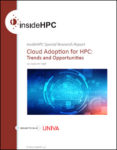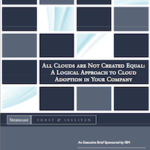This whitepaper is an insideHPC Special Research Report sponsored by Univa. “Today many organizations solve their most difficult computational challenges by creating their own on-premises, compute-intensive, high performance data center. The latest hardware and software innovations have removed barriers that prevented many organizations from embracing HPC solutions. With more enterprises extending their own on-premises clusters into the cloud with hybrid configurations, finding the right tools for managing and scheduling workflows and automatically controlling cost remains a critical challenge.”
Cloud Adoption for HPC: Trends and Opportunities
This whitepaper is an insideHPC Special Research Report sponsored by Univa® Corporation: Cloud Adoption for HPC:
Trends and Opportunities. Recently, InsideHPC ran a survey, sponsored by Univa, to identify the trends and opportunities for adoption of HPC workflows in the cloud. There were 143 respondents: 39% academic/non-profit, 17% manufacturing or engineering, 11% government research; 59% North America, 24% Europe, 8% Asia; 59% with less than 20,000 employees. This whitepaper is a summary of what was learned from this survey.
The HPC Transition to the Cloud
This is the first entry in an insideHPC series that explores the HPC transition to the cloud, and what your business needs to know about this evolution. Compiled in a complete Guide, we cover cloud computing, industry examples, IaaS components, OpenStack fundamentals, and more.
Cloud Adoption in Your Community
In conference rooms worldwide, enterprise IT departments are evaluating entry into ‘the cloud’. Armed with media reports and marketing materials, they are considering questions like, “Is the cloud appropriate for critical workloads? Will the cloud really save time and money? Does the cloud pose a security risk?”
There’s only one problem with such due diligence: there’s no such thing as ‘the cloud’. Instead, there are multiple clouds, with different configurations, offered by different providers and representing different degrees of benefit and risk.





